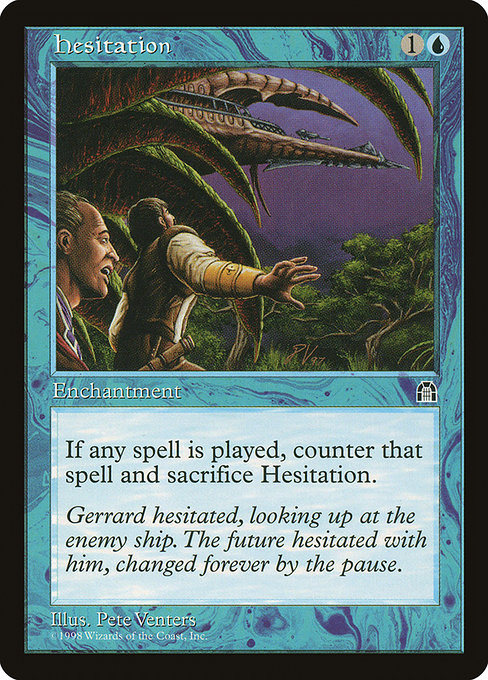
Image courtesy of Scryfall.com
Hesitation and the Cognitive Load of Layered MTG Effects
Blue has always thrived on timing puzzles, and Hesitation is a compact, razor-edged reminder of how a single card can tilt the pace of an entire match. Printed in Stronghold as an uncommon enchantment with a modest cost of {1}{U}, it asks the mind to juggle two sharp realities at once: a spell is being cast, and the enchantment that watches over the stack is about to vanish in order to counter that spell. The flavor text—Gerrard hesitating, staring at a future that would be forever altered—isn’t just lore; it’s a cognitive lens: hesitation itself becomes a mechanism that shapes the outcome. 🧙♂️🔥💎
What makes Hesitation a particularly instructive example is how it embodies layered MTG effects in a tiny footprint. The card’s rule text is crystal-clear on the surface—“When a player casts a spell, sacrifice this enchantment and counter that spell.” Sounds simple, right? But the actual play pattern invites a student of the game to track the stack, timing windows, and the moment of sacrifice all at once. In a single moment, players consider the spell on the stack, the potential responses, and the fact that the enchantment itself will be gone after the spell is countered. That confluence—stack dynamics, timing, and a one-shot interaction—creates a palpable cognitive load that contemporary designs experiment with in ever more elaborate ways. 🎲
“Gerrard hesitated, looking up at the enemy ship. The future hesitated with him, changed forever by the pause.”
From a design perspective, Hesitation is a study in efficient communication. The card uses a clean mana cost, a single-word trigger, and a highly specific outcome that players can grasp with a moment’s attention. Yet that simplicity masks a deeper structural complexity: a counter-spell that is not just an effect to stack, but a careful negotiation with the game state. You’re not just saying “no” to a spell; you’re acknowledging the cost of your own ongoing influence on the table. In terms of cognitive psychology, this is a deliberate design that nudges players toward metacognition—thinking about one’s own thinking as spells fizz on the stack. 🧠🔥
Layered effects like Hesitation often ride the razor’s edge between elegance and overwhelm. The enchantment’s one-shot nature—sacrifice upon the next spell cast—creates a paradoxical sense of control and constraint: you can shape the moment, but you pay the moment’s price in real time. For newer players, this can be a bridge too far, a momentary overload that slows the tempo of decision-making. For veterans, it’s a welcome invitation to play the long game, where every cast becomes a thread in a larger tapestry of tempo and counterplay. In either case, the card remains a memorable touchstone for how layered interactions influence both strategy and psychology at the table. ⚔️🎨
How the card informs modern discussions of cognitive load
When we talk about cognitive load in complex card effects, Hesitation offers a tangible case study. It foregrounds three key ideas:
- Trigger clarity matters. The moment you identify that a spell is being cast, you must immediately decide whether to allow the counter or let the spell resolve. This immediate trigger imposes a narrow window for decision-making, which can intensify pressure in high-stakes games.
- One-shot effects have outsized impact. Because the enchantment is sacrificed on the spell’s casting, players must weigh not just the current spell, but also whether future spells will matter if Hesitation is no longer around. The cost is not only the countered spell but the potential timing flexibility for later plays.
- Understanding rules text at a glance. Hesitation rewards familiarity with stack rules, but it also teaches that good card design can convey deep mechanical ideas with minimal words. The result is a payoff in both playability and flavor—a card that feels like it belongs to a world that respects the power of a pause that changes history. 🧙♂️
For players who enjoy exploring the cognitive side of the game, Hesitation is a natural conversation starter about how much information a card should convey and how quickly it should invite a decision. It’s also a reminder that older sets—like Stronghold—delivered some of the most piercing micro-designs in MTG history. The art, the flavor, and the rules text align to create experiences that feel both timeless and lockstep with the modern appreciation for complexity. This is the kind of card that makes you appreciate the joy of deliberate play, where a pause can tilt the trajectory of the entire game. 🧩
Lessons for designers and players alike
Designers aiming to balance readability with depth can take inspiration from Hesitation’s compact footprint. Consider these practical takeaways:
- Be precise about timing windows. A trigger that happens “when a spell is cast” benefits from unambiguous timing cues so players can act without ambiguity during fast play sessions.
- Highlight the cost of interaction. Sacrificing the effect as part of the counter helps players appreciate the trade-off, reinforcing a thoughtful approach to engagement rather than rushed reflexes.
- Use flavor to support mechanics. The Gerrard flavor text grounds the mechanical hesitation in a story moment, reminding players that MTG’s rules can carry narrative weight as well as mathematical weight. 🧠🔥
As a cross-promotional nod, the product we’ve linked below makes for a great companion to a modern MTG tabletop setup—a reminder that the hobby isn’t all complex probability trees; it’s also about the tactile, sensory experience of magic on the table. And if you’re curious to see how other writers approach tempo and power across sets, the five linked articles below provide a varied cross-section of strategic thinking in the MTG cosmos. 🔥💎⚔️
Shockproof Phone Case: Durable TPU/Polycarbonate ShellMore from our network
- https://blog.digital-vault.xyz/blog/post/murderous-compulsion-power-scaling-across-mtg-sets/
- https://blog.digital-vault.xyz/blog/post/profit-loss-tempo-advantage-for-dimir-control/
- https://transparent-paper.shop/blog/post/negative-parallax-whisper-from-a-32000-k-star-at-2-kpc/
- https://blog.digital-vault.xyz/blog/post/subduing-the-board-imperial-subduer-inspired-archetypes/
- https://blog.digital-vault.xyz/blog/post/the-first-eruption-and-unhinged-comedy-in-mtg-cards/